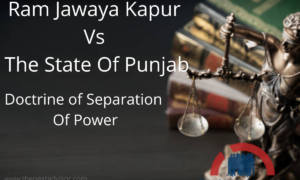The Statute should be read as a whole or construction ex Viscribus actus 0f the important general principle of interpretation is that the statute should be read as a whole and all parts of it taken together while construing a provision. This principle is also stated that a statute is to be interpreted also stated as that a statute is to be interpreted ex visceribus actus, that is no say, Scribus actus, that is no say, within four corners of the Act.
A provision cannot be interpreted in isolation. Sometimes, the meaning of words may be determined by other words used in the same section while in some cases a section may be interpreted in the light of some other sections in the same statute. The idea is to make a consistent enactment of the whole statute and for this, the context and other provisions of the Act are important considerations.
The court should, however, be careful not to carry too far the construction of a provision with the help of other provisions and should do so only when it feels that the legislature must have so intended. Doubt in the mind legislature must have so interested. Similarly, a word used in the same section more than once will have the same meaning normally. There may sometimes be compelling reasons for not interpreting a particular section in the light of another section.
In all cases, the scheme of the Act as a whole should be the guideline factor. Nothing is better settled than that a statute is to be expounded, not according to the letter, but according to the meaning and spirit of it. What is within the true meaning and spirit of the statute is as much law as what is within the very letter of it, and that which is not within the meaning and spirit, though it seems to be within the latter, is not the law and is not the statute. The effect that should be given to the object, spirit, and meaning of a statute is a rule of legal construction, but the object, spirit, and meaning must be collected from the words used in the statute.
It must be such an intention as the legislature has used fit words to express. This rule should not be used when the meaning of a provision is clear. The rule applies to interpreting only obscurely penned statutes. No particular phrase of a statute is to be interpreted detached from its context. The whole context should be viewed. The intention of the legislature is gatherable from any view. The intention of the legislature from any other part of an Act must be considered during construing a provision of that Act.
EX VISCRIBUS ACTUS – A statute should be read as a whole. An important principle of interpretation is that the statute should be read as a whole. No provision in statute and no words in a section should be construed in isolation. All parts of the statute should be taken together.
Case Law – STATE OF WEST BENGAL VS. NION OF INDIA 1964 – The Supreme Court observed that to determine the intent of the legislature, only a particular section of the statute not only see but the whole statute should be read to determine the true intention and to discover that purposes of the legislature.
Case Law – BHAVNAGAR UNIVERSITY VS. PALITANA SUGAR MILLS PVT. LTD. AIR 2003 – The Hon’ble Apex Court opined that one of the basic principles of the construction of the statute is that it should be read as a whole, then chapter, section by section, and word by word.



























